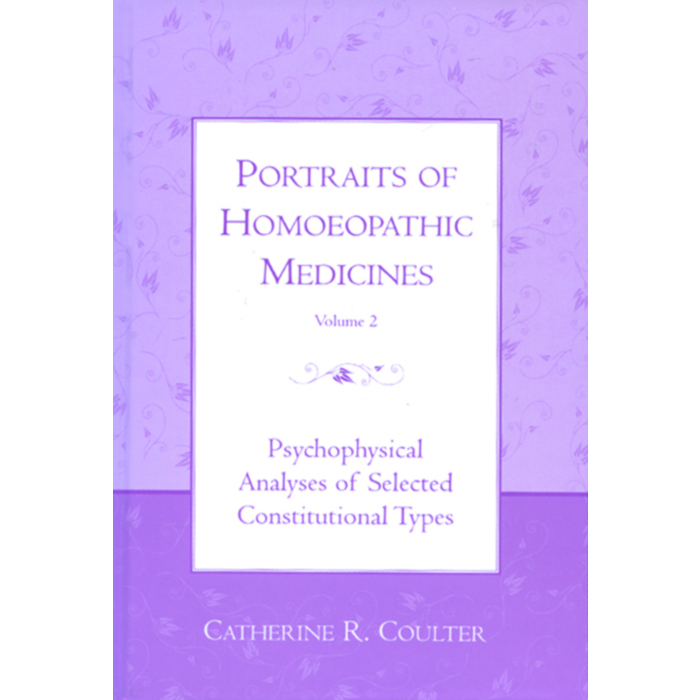Portraits of Homoeopathic Medicines: Psychophysical Analyses of Selected Constitutional Types v. 2
Share on social media
Volume 2 - Psychophysical Analyses of Selected Constitutional Types - Nux Vomica, Silica, and Ignatia. Nosodes and Comparative Materia Medica.
| ISBN | 9780971308220 |
|---|---|
| Author | Catherine R. Coulter |
| Type | Hardback |
| Language | English |
| Publication date | 2003-12 |
| Pages | 300 |
| Publisher | Ninth House Publishing |
| Review | This book review is reprinted with the permission of the American Institute of Homeopathy What is at once interesting and disconcerting about homeopathy is that some of the best teachers and authors worldwide in the homeopathic movement are lay persons who have become so knowledgeable about homeopathy that professionals flock to learn from them. From England we have Sheilagh Creasy with over 38 years experience practicing and teaching in South Africa, India, China and (currently), England. From Greece comes the celebrated George Vithoulkas who now has a world-wide following and is the author of two major books on homeopathy. Here in the United States we have Catherine R. Coulter whose homeopathic portraits she initially popularized via her lectures at the National Center for Homeopathy's summer courses and later brought into book form in Portraits of Homoeopathic Medicines (Volume 1) . We now welcome Mrs. Coulter's second volume of Portraits of Homeopathic Medicines. Though the tone is conversational, almost chatty, the scholarship is impressive. Her bibliography contains references to 26 homeopathic authors and their 33 books and journal articles. Mrs. Coulter's forte is describing the polychrests from the psychological point of view. She has been criticized for 'psychologizing' about homeopathy, but in my view that is unfair. After all, it is her stated intention to explore in depth the major remedies from the psychological aspect. Indeed, she does her job well, often brilliantly. At the same time, scattered throughout her portraits are clinical gems which pertain not only to the mental and emotional planes but also to the physical. For example, she gives 23 examples of the contradictoriness of Ignatia on the physical plane (p.140-141). Another clinical pearl is the fact that she will repeat Ignatia in high potency quite frequently with no untoward effects. I, too, have found this to be the case. Ignatia can be repeated ad lib in hysterical subjects or persons suffering the shock of bereavement with no adverse effects. Indeed, it often must be repeated frequently if we are to see the patient through an emotionally trying time. In her chapter on Psorinum I was delighted to read her caution (but stressed by a quote from Hahnemann) against giving Psorinum high as the first remedy in certain acute skin conditions. She related how she once gave a 1M potency of Psorinum to a man suffering from severe eczema and obtained an horrendous aggravation which lasted for weeks. In general, I not only liked Mrs. Coulter's book, but I believe it to be a work from which both inexperienced as well as experienced homeopaths can learn. JOURNAL OF THE AMERICAN INSTITUTE OF HOMEOPATHY DECEMBER 1988. |
Review
This book review is reprinted with the permission of the American Institute of Homeopathy
What is at once interesting and disconcerting about homeopathy is that some of the best teachers and authors worldwide in the homeopathic movement are lay persons who have become so knowledgeable about homeopathy that professionals flock to learn from them. From England we have Sheilagh Creasy with over 38 years experience practicing and teaching in South Africa, India, China and (currently), England. From Greece comes the celebrated George Vithoulkas who now has a world-wide following and is the author of two major books on homeopathy. Here in the United States we have Catherine R. Coulter whose homeopathic portraits she initially popularized via her lectures at the National Center for Homeopathy's summer courses and later brought into book form in Portraits of Homoeopathic Medicines (Volume 1) .
We now welcome Mrs. Coulter's second volume of Portraits of Homeopathic Medicines. Though the tone is conversational, almost chatty, the scholarship is impressive. Her bibliography contains references to 26 homeopathic authors and their 33 books and journal articles.
Mrs. Coulter's forte is describing the polychrests from the psychological point of view. She has been criticized for 'psychologizing' about homeopathy, but in my view that is unfair. After all, it is her stated intention to explore in depth the major remedies from the psychological aspect. Indeed, she does her job well, often brilliantly. At the same time, scattered throughout her portraits are clinical gems which pertain not only to the mental and emotional planes but also to the physical. For example, she gives 23 examples of the contradictoriness of Ignatia on the physical plane (p.140-141).
Another clinical pearl is the fact that she will repeat Ignatia in high potency quite frequently with no untoward effects. I, too, have found this to be the case. Ignatia can be repeated ad lib in hysterical subjects or persons suffering the shock of bereavement with no adverse effects. Indeed, it often must be repeated frequently if we are to see the patient through an emotionally trying time.
In her chapter on Psorinum I was delighted to read her caution (but stressed by a quote from Hahnemann) against giving Psorinum high as the first remedy in certain acute skin conditions. She related how she once gave a 1M potency of Psorinum to a man suffering from severe eczema and obtained an horrendous aggravation which lasted for weeks.
In general, I not only liked Mrs. Coulter's book, but I believe it to be a work from which both inexperienced as well as experienced homeopaths can learn.
JOURNAL OF THE AMERICAN INSTITUTE OF HOMEOPATHY DECEMBER 1988.

